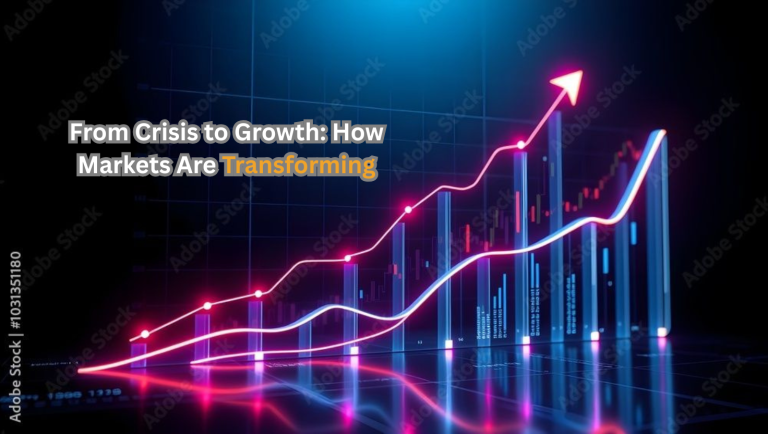omanreport exploration of one of the most fascinating economic phenomena of our time — the transformation of markets from turbulent crises to unprecedented growth. The global economy has faced shocks that once seemed insurmountable — financial crashes, pandemic disruptions, political instability — yet, somehow, markets have bounced back, evolved, and even flourished. This transformation is not just a story of recovery but of reinvention, innovation, and resilience.
Let’s dive deep into the strategies, forces, and hidden patterns that drive markets from collapse to comeback — and uncover what you can learn to ride these waves successfully.
The Journey from Market Panic to Market Power
Why Crises Often Spark Innovation
It might seem counterintuitive, but history shows that crises often force businesses and governments to innovate faster. When faced with a downturn, companies are pushed to reduce waste, embrace new technologies, and rethink how they deliver value.
- Efficiency Becomes a Necessity – During recessions, every dollar counts. This forces businesses to streamline operations, adopt automation, and experiment with cost-cutting innovations.
- Consumer Behavior Changes – People become more selective with their spending, forcing companies to become more creative in attracting them back.
- New Industries Rise – Some of the biggest tech booms in history happened after major crises, like the dot-com crash or 2008 recession.
The Role of Government and Policy
Markets rarely recover on their own — governments often play a crucial role in stabilizing economies. Central banks adjust interest rates, introduce stimulus packages, and inject liquidity into markets to encourage spending and investment.
These moves don’t just bring short-term relief but can also pave the way for long-term growth by fostering a climate of entrepreneurship and financial optimism.
Key Drivers of Market Transformation
Technological Breakthroughs
Innovation is at the heart of every recovery. Whether it’s fintech solutions making investing easier, AI revolutionizing productivity, or green energy reshaping industries, technology serves as the catalyst that accelerates change.
Shifts in Global Trade
Market crises often lead to realignments in international trade. Countries diversify supply chains, open new markets, and invest in domestic production — all of which can create new opportunities for businesses and investors.
Investment Trends
Crises often create discounted assets, giving savvy investors opportunities to buy low and benefit when recovery kicks in. This is why many fortunes are built during downturns rather than during times of economic stability.
The Human Element in Market Recovery
Psychology of Market Participants
Fear and greed are powerful forces that drive market behavior. Understanding how sentiment shifts from panic to confidence is crucial for predicting where markets will head next.
Role of Entrepreneurship
Small businesses and startups are often the first to experiment with new models. Their agility allows them to pivot quickly, creating innovative products and services that fuel overall growth.
Strategies for Thriving in Transforming Markets
Diversification as a Safety Net
Investors and businesses that spread risk across multiple sectors, assets, and regions are better positioned to weather crises and capture growth opportunities.
Embracing Digital Transformation
Companies that adopt digital tools early not only survive but thrive during times of disruption. Digital payments, e-commerce platforms, and remote work solutions have become non-negotiables.
Focusing on Sustainable Growth
Sustainability is no longer just a buzzword. Markets are rewarding companies that think long-term, reduce environmental impact, and prioritize corporate responsibility.
Lessons from Past Market Recoveries
The 2008 Financial Crisis
Banks collapsed, real estate markets imploded, and millions lost jobs — but it also gave rise to fintech, blockchain innovation, and stricter regulations that made the financial sector more resilient.
The Pandemic Recession
COVID-19 shut down global markets, but it also accelerated digital adoption, e-learning, telehealth, and e-commerce by almost a decade.
What the Future Holds
Markets will continue to face turbulence, but every crisis also opens the door to reinvention. Emerging markets, AI-driven economies, and decentralized finance (DeFi) are shaping a future that may look radically different from today’s systems.
FAQs
How do markets recover after a crisis?
Markets recover through a combination of government intervention, investor confidence returning, and technological or structural changes that rebuild growth potential.
Is it safe to invest during a market downturn?
Yes, if done wisely. Downturns often provide discounted entry points, but diversification and research are essential to minimize risk.
Which sectors benefit most after a crisis?
Technology, healthcare, infrastructure, and consumer essentials often lead the recovery, as they meet urgent needs and adapt faster to change.
How can small businesses survive market turbulence?
By staying lean, embracing digital solutions, and adapting quickly to new consumer demands, small businesses can not only survive but also grow.
Are current market transformations sustainable?
Yes, many are — especially those driven by technological innovation and sustainability trends. However, vigilance is key as global factors can still create volatility.
Conclusion
From panic to prosperity, the story of market transformation is a powerful reminder that every downturn is an opportunity in disguise. perujournal.com believes that understanding these cycles empowers investors, entrepreneurs, and everyday individuals to make smarter decisions.
By staying informed, embracing innovation, and thinking long-term, you can position yourself to not only survive crises but to thrive in the new waves of growth they inevitably bring.


